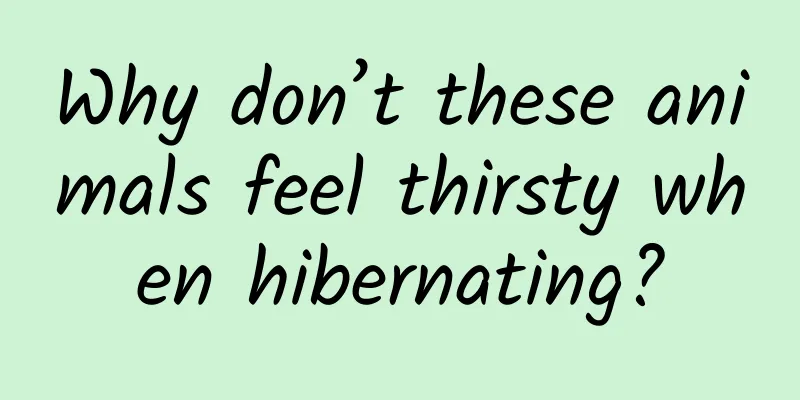Why don’t these animals feel thirsty when hibernating?

|
Produced by: Science Popularization China Author: Su Chengyu Producer: China Science Expo Editor's note: In order to understand the latest developments in cutting-edge science and technology, the China Science Popularization Frontier Science Project has launched a series of articles titled "Understanding Top Science Journals", which selects outstanding papers from authoritative journals and interprets them in plain language as soon as possible. Let us broaden our scientific horizons and enjoy the fun of science through the window of top journals. On the grasslands of North America, thirteen-striped ground squirrels are sleeping underground. Sleeping thirteen-striped ground squirrel (Image source: Courtesy of the Gracheva lab) Hibernation is not uncommon for them, but a mystery fascinates researchers: how this ground squirrel can curl up in its burrow in the winter without taking in any water and still miraculously survive. This mystery attracted two researchers at Yale University, Elena Gracheva and Sviatoslav Bagriantsev. The scientists wondered if these little ground squirrels really didn't need water, or if their bodies had found some way to "fight thirst." The results of the study were eventually published in Science. Hibernating ground squirrels do need water To find the answer, Gracheva and her team decided to start with changes in body fluids. They first focused on two states of ground squirrels during hibernation: low-temperature hibernation and intermittent awakening. When in low-temperature hibernation, the squirrel's body is like a "standby" machine, with its body temperature dropping to near freezing and its metabolism almost stopped. During intermittent awakening, the squirrel's body temperature rises to 37°C, and its vital signs such as heartbeat and breathing also return to "active mode", but they do not go out to forage for food or drink water. Interbout Arousal (IBA) is a special state in which hibernating animals wake up briefly during a long hibernation process. This state is very common in all hibernating animals, such as ground squirrels, hedgehogs and bats. Although these animals spend most of their time in a low-metabolism "cold hibernation" state, they experience a short awakening process every few weeks. The left side shows a squirrel drinking water in an active state, and the right side shows a squirrel in an intermittently awake state. Squirrels in a state of intermittent arousal did not seem keen on drinking directly from the water. (Image source: Reference 1) Scientists started by testing the blood of squirrels to find "clues" of thirst. They analyzed blood samples from squirrels that were "awakened" from low-temperature hibernation and intermittent awakening, and found some interesting changes: during intermittent awakening, the level of angiotensin II (a hormone that can make people feel strong thirst) in the blood of squirrels was twice as high as usual, and the level of aldosterone (a hormone that promotes the retention of sodium and water in the body) was three times higher than usual! A: In the intermittent arousal state (IBA), the serum angiotensin II concentration is significantly higher than that in the active state (Active) B: The serum aldosterone level in the intermittent arousal state (IBA) is significantly higher than that in the active state. (Image source: Reference 1) Logically, these elevated hormone levels should make them thirsty, but oddly, the squirrels showed no desire to drink. The scientists also conducted a comparative experiment in which they asked active squirrels to choose between normal drinking water and concentrated salt water. The results showed that the active squirrels drank almost no salt water, but the squirrels in the intermittent awake state drank salt water in large gulps, and obviously had a higher demand for salt water. This shows that the squirrels' bodies are indeed dehydrated during hibernation, but they suppress their desire for water and instead prioritize salt intake, an element that is essential for maintaining fluid balance. Active squirrels spent significantly more time drinking water (blue curve) than 0.5 M NaCl solution (pink curve). (Image source: Document 1) Like camels in the desert, squirrels' bodies seem to have a special wisdom that allows them to "distinguish the primary from the secondary" and pay more attention to electrolyte balance rather than simply replenishing water when they are dehydrated. But they found a way to fight thirst Next, the scientists turned their attention to the brain of ground squirrels, specifically two areas responsible for regulating body fluids: the subfornical organ (SFO) and the organ of vascular lamina terminalis (OVLT). These areas act like "thirst alarms," sending signals to the brain when the blood is too salty or too dry, making us thirsty. Location of the SFO and OVLT in the brain of ground squirrels (Photo credit: frontiersin) To see if these areas had "turned off the alarm," the research team conducted a very clever experiment. They injected squirrels with a fluorescently labeled angiotensin II to see if the hormone could still "light up" normally in the hibernating squirrels' brains. Thirteen-striped ground squirrel (Image source: thescientist) But when scientists further tested these neurons using electrophysiological techniques, they found a major clue: Although hibernating neurons can receive signals, their activity is greatly reduced, as if the "mute button" was pressed. More interestingly, these neurons are very sensitive to an inhibitory chemical called GABA, which acts like a pair of earplugs , making neurons "inaudible" to thirst signals. In simple terms, when the thirteen-striped ground squirrel is short of water, it can suppress the activity of thirst neurons in the brain and concentrate energy on more critical physiological needs. This mechanism shows that thirst is not completely shut down, but is "adjusted" to a state more suitable for hibernation. Thirteen-striped ground squirrel (Image source: Squirrel Gazer) In terms of dealing with hunger, scientists have found some answers from the Daurian ground squirrel (Citellus dauricus). In 2009, scientists discovered that this squirrel will reduce its metabolic rate to a minimum when hibernating, just like a computer in standby mode, keeping only the most basic "background operations". Daurian Ground Squirrel (Image source: gbif) Scientists tested their metabolic enzymes and brown adipose tissue (BAT) activity and found that their resting metabolic rate dropped to only 10% of that in summer, and almost every bite of fat was carefully stored and used. The enzyme activity in brown fat (BAT) increased rapidly when needed, helping them to quickly heat up during occasional "short awakenings", just like a heater that has just been plugged in. Brown fat is a special type of fat tissue. Unlike the familiar "normal fat" - white fat (WAT), its main function is not to store energy, but to generate heat to help maintain body temperature. It can be regarded as the body's "biological radiator", which is particularly important in cold environments. This energy management ability allows the Daurian ground squirrel to calmly survive the days without food during the five-month hibernation. Do you not need to urinate during hibernation? The thirst is solved, but what about urine? If you don't pee, won't toxins accumulate in your body? But for Arctic ground squirrels (Spermophilus parryii), it is a "resource" that can be recycled. Arctic ground squirrel hibernating (Image source: guardian) In 2014, Professor Brian Barnes of the University of Alaska found that these squirrels hardly urinate during hibernation, but their bodies are not poisoned by the accumulation of toxins. The reason is that their intestinal microorganisms are like a "chemical factory" that can break down urea into amino acids for reuse. This mechanism not only reduces the accumulation of metabolic waste, but also allows squirrels to maintain necessary protein synthesis during hibernation. Speaking of extreme hibernation strategies, we have to mention the North American wood frog (Rana sylvatica). These frogs literally freeze into "ice cubes" in the winter, with their hearts stopping and their blood freezing, but in the spring, they can miraculously revive. How do they do it? Wood frogs of North America (Image source: EarthlyMission) Scientists have found that before these frogs freeze, they release a large amount of glucose into their blood. These sugars act like antifreeze, protecting their cells from being punctured by ice crystals, just like a well-stored ice cream that will not turn into a puddle of water even after being frozen and thawed. Conclusion Whether it is the ground squirrel that never gets thirsty, the Daurian ground squirrel that is an energy-saving expert, or the wood frog that is a master of freezing, each life is showing the amazing art of survival in its own way. And we may be standing on the shoulders of these animals' wisdom to find the answers to the future. References: 1.Junkins MS, Feng NY, Merriman DK, et al. Suppression of neurons in circumventricular organs enables months-long survival without water in thirteen-lined ground squirrelsJ. Science, 2024, 386(6725): 1048-1055. 2. Yang Ming, Xing Xin, Guan Shujun, et al. Changes in body temperature and hibernation patterns of Daurian ground squirrels during hibernation. J. Theriologica Sinica, 2011, 31(4): 387. 3.Sallmen T, Lozada AF, Anichtchik OV, et al. Changes in hippocampal histamine receptors across the hibernation cycle in ground squirrelsJ. Hippocampus, 2003, 13(6): 745-754. 4.Oelkrug R, Goetze N, Meyer CW, et al. Antioxidant properties of UCP1 are evolutionarily conserved in mammals and buffer mitochondrial reactive oxygen speciesJ. Free Radical Biology and Medicine, 2014, 77: 210-216. 5.Cooper EL, Wright RK, Klempau AE, et al. Hibernation alters the frog's immune systemJ. Cryobiology, 1992, 29(5): 616-631. |
Recommend
More than 5,000 bags caught in 8 days! A power plant was "massively invaded" by jellyfish. What's the reason?
"There is no way to catch them all! There is...
Let’s take a look at the “marketing madman” Luo Yonghao, he is really tough!
In the past two days, there has been new progress ...
Marketing promotion: Is your marketing plan effective?
How to put a good idea into practice? Are there a...
To prevent artificial intelligence from betraying humanity, Google, Microsoft and other giants are determined to work together
From "2001: A Space Odyssey" to "T...
Is the "big crab" in the night sky a trace left by an unusual celestial body thousands of years ago?
Author | Feng Ziyang Review | Dong Chenhui, Zhao ...
How does the catering industry make money from short videos?
I recently saw a video where a small noodle shop ...
Should community O2O bypass property management?
On the one hand, the media is constantly promotin...
She protected 242 gorillas and spent her life alone in the forest
In the early morning of December 27, 1985, zoolog...
On the third day of the first lunar month, burn door god paper to pray for peace and prosperity. Do these five things to ensure auspiciousness.
The third day of the first lunar month is also kn...
Automating the building of Android and iOS apps with Jenkins
background As business needs evolve, the complexi...
What kind of marketing plan can be implemented?
My personal summary is that the marketing goals c...
Intellectual Academy "Intellectual Training Camp 2.0" fully upgrades your thinking ability
Intellectual Academy "Intellectual Training ...
There are so many colors of sunglasses, how do you choose?
The scorching sun makes it hard to open your eyes...
Watch Nongmin Films for free as a VIP, and watch all VIP movies online for free!
You can watch VIP TV series for free on Nongmin F...
Rethinking private domain traffic in the post-WeChat era
There are some new concepts in the marketing indu...









